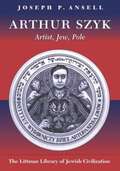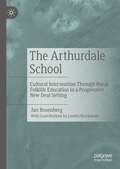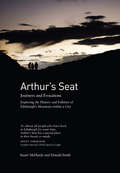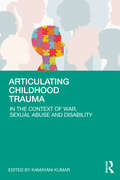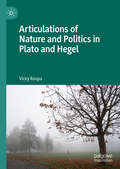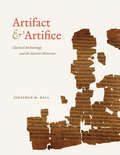- Table View
- List View
Arthur Sullivan: A Victorian Musician (Routledge Revivals)
by Arthur JacobsPublished in 1992. This is a revised, enlarged edition of a book which on its original appearance in 1984 was hailed as a landmark in the study of Victorian musical life. It presents the figure of Sir Arthur Sullivan (1842-1990) not only as the celebrated co-creator of light operas with W.S Gilbert, but as a composer of all kinds of music from symphony and concerto to ballads such as ‘The Lost Chord’ and hymns such as ‘Onward, Christian Soldiers’. A prominent public life, with a knighthood in 1883, is contrasted with an unconventional private life involving a liaison of almost thirty years with an American living in London, Mary Frances Ronalds. The author’s access to Sullivan’s diary held by Yale University and to letters and other documents at the Pierpont Morgan library in New York gives this book both a unique authority and a deep human understanding. A new chapter updates research to the 150th anniversary of the composer’s birth, 1992, and incorporates music examples.
Arthur Szyk: Artist, Jew, Pole (The Littman Library of Jewish Civilization)
by Joseph P. AnsellArtist and illustrator Arthur Szyk was a Polish Jew whose work was overwhelmingly Jewish in theme and content. In a lifetime of creativity that spanned many of the major events of the twentieth century and took him from Poland to France, England, and the United States, the mission he set himself was to use his artistic talents to serve humanity and the Jewish people. Though his politics were dictated by what he thought would be good for the Jews, his work as a political artist went well beyond a narrow definition of the Jewish cause. He is best known among Jews for his illustrated Haggadah, but the overwhelming majority of his work deals with contemporary political themes and social causes. In his native Poland, Szyk promoted the causes of freedom, toleration, and human dignity, drawing his inspiration from the Old Testament. He believed that as a Jewish artist he had a responsibility to speak for all minorities. His famous illustration of the historical Statute of Kalisz symbolized his belief that the newly re-established Polish state would welcome all its citizens into full and equal participation. Even though at that time he was already based outside Poland, he worked for many years on behalf of the Polish government in an effort to strengthen the Jews’ position. Szyk left Europe in 1940 and arrived in the United States via Canada later the same year. Determined as ever to use his art for political purposes, he crusaded against the Nazis through newspaper and magazine cartoons, posters and public exhibitions. Convinced that Hitler would not stop with the Jews but would suppress all freedom-loving people, he supported the war effort through his striking propaganda images of the German and Japanese armies, to great effect. After the war he turned his efforts to promoting the idea of a Jewish homeland in Israel. In every phase of his career, one finds Szyk looking to the past but hoping for the future; he believed that art could make a difference in the world, politically and socially. Joseph Ansell’s biography makes a singular contribution to the history of Jewish art and of Polish-Jewish relations in the first half of the twentieth century.
The Arthurdale School: Cultural Intervention Through Rural Folklife Education in a Progressive New Deal Setting
by Jan RosenbergThis book chronicles the school envisioned by Eleanor Roosevelt in 1933 to serve Arthurdale, the New Deal government-created community in north-central West Virginia. Arthurdale was founded to house unemployed miners and their families and provide them with opportunities to receive healthcare and obtain gainful employment. Roosevelt had a particular interest in the education of children, feeling that education and social life were profoundly intertwined within a community. With that in mind, in 1934, she hired Elsie Ripley Clapp—an educator and leader in the Progressive Education movement—to design and implement the school, as well as oversee the social life of Arthurdale as a whole. In addition to covering the Arthurdale School's birth, life, and dissolution, Rosenberg discusses how the lessons of the school might serve the culture of education today, especially as an element of a comprehensive approach to community revitalization.
Arthur's Seat: Journeys and Evocations (Journeys And Evocations Ser. #1)
by Stuart McHardyArthur's Seat is climbed (or walked up and around) by thousands of people each year. The views from the top of the 350-million year old landmark are breathtaking. In this book, Stuart McHardy and Donald Smith interweave the tales of folklore and customs that surround this iconic hill. Review Draws on folklore tales and real life stories to create a unique walkers' guide to the famous ridges, crags and valleys that make up the hill. EDINBURGH EVENING NEWS Back Cover: Standing in the Hunter's Bog with the Salisbury Crags to the west, Dasses to the east and the great summit crag rising above, you could be deep in the Highlands. There is no sight and very little sound of the modern cityscape all around. STUART McHARDY Arthur's Seat, rising high above the Edinburgh skyline, is the city's most awe-inspiring landmark Although thousands climb to the summit every year, its history remains a mystery, shrouded in myth and legend. Quickly and suddenly we lose the sense of ciy. Through the park is now surrounded by Edinburgh, it still retains a sense of wildness. DONALD SMITH The first book of its kind, Arthur's Seat: Journeys and Evocations is a salute to the ancient tradition of storytelling, guiding the reader around Edinburgh's famous 'Resting Giant' with an exploration of the local folklore and customs associated with the mountain-within-a-city. Inspired by NVA's Speed of Light, a major event in Edinburgh's International Festival and the country-wide Cultural Olympiad, Journeys and Evocations brings together past and future in a perspective of the Edinburgh landscape like no other. A place where time does not pass but simply adds up. ROBERT GARIOCH
Articulate Necrographies: Comparative Perspectives on the Voices and Silences of the Dead
by Anastasios Panagiotopoulos Diana Espírito SantoGoing beyond the frameworks of the anthropology of death, Articulate Necrographies offers a dramatic new way of studying the dead and their interactions with the living. Traditional anthropology has tended to dichotomize societies where death “speaks” from those where death is “silent” – the latter is deemed “scientific” and the former “religious” or “magical”. The collection introduces the concept of “necrography” to describe the way death and the dead create their own kinds of biographies in and among the living, and asks what kinds of articulations and silences this in turn produces in the lives of those affected.
Articulate Necrographies: Comparative Perspectives on the Voices and Silences of the Dead
by Diana Espírito Santo Anastasios PanagiotopoulosGoing beyond the frameworks of the anthropology of death, Articulate Necrographies offers a dramatic new way of studying the dead and their interactions with the living. Traditional anthropology has tended to dichotomize societies where death “speaks” from those where death is “silent” – the latter is deemed “scientific” and the former “religious” or “magical”. The collection introduces the concept of “necrography” to describe the way death and the dead create their own kinds of biographies in and among the living, and asks what kinds of articulations and silences this in turn produces in the lives of those affected.
Articulate Necrographies: Comparative Perspectives on the Voices and Silences of the Dead
by Diana Espírito Santo Anastasios PanagiotopoulosGoing beyond the frameworks of the anthropology of death, Articulate Necrographies offers a dramatic new way of studying the dead and their interactions with the living. Traditional anthropology has tended to dichotomize societies where death “speaks” from those where death is “silent” – the latter is deemed “scientific” and the former “religious” or “magical”. The collection introduces the concept of “necrography” to describe the way death and the dead create their own kinds of biographies in and among the living, and asks what kinds of articulations and silences this in turn produces in the lives of those affected.
The Articulated Peasant: Household Economies In The Andes
by Enrique MayerBased on Enrique Mayer's 30 years of research in Peru, this collection of new and revised essays presents in one accessible volume Mayer's most significant statements on Andean peasant economies from pre-colonial times to the present. As a result, The Articulated Peasant is noteworthy as a sustained examination of household economies as the author explains the relationship of the household and the village community to the Andean mountain environment through systems of land use and agricultural production within changing historical circumstances. Though the volume stresses the Andean context, its relevancy is wider. It will resonate with those who are struggling with issues of survival and development in Latin America or elsewhere where units of production and consumption are largely household based.
The Articulated Peasant: Household Economies In The Andes
by Enrique MayerBased on Enrique Mayer's 30 years of research in Peru, this collection of new and revised essays presents in one accessible volume Mayer's most significant statements on Andean peasant economies from pre-colonial times to the present. As a result, The Articulated Peasant is noteworthy as a sustained examination of household economies as the author explains the relationship of the household and the village community to the Andean mountain environment through systems of land use and agricultural production within changing historical circumstances. Though the volume stresses the Andean context, its relevancy is wider. It will resonate with those who are struggling with issues of survival and development in Latin America or elsewhere where units of production and consumption are largely household based.
Articulating Childhood Trauma: In the Context of War, Sexual Abuse and Disability
by Kamayani KumarThe volume addresses the pertinent need to examine childhood trauma revolving around themes of war, sexual abuse, and disability. Drawing narratives from spatial, temporal, and cultural contexts, the book analyses how conflict, abuse, domestic violence, contours of gender construction, and narratives of ableism affect a child’s transactions with society. While exploring complex manifestations of children’s experience of trauma, the volume seeks to understand the issues related to translatability/representation, of trauma bearing in mind the fact that children often lack the language to express their sense of loss. The book in its study of childhood trauma does a close exegesis of select literary pieces, drawings done by children, memoirs, and graphic narratives.Academicians and research scholars from the disciplines of childhood studies, trauma studies, resilience studies, visual studies, gender studies, cultural studies, disability studies, and film studies stand to benefit from this volume. The ideas that have been expressed in this volume will richly contribute towards further research and scholarship in this domain.
Articulating Childhood Trauma: In the Context of War, Sexual Abuse and Disability
The volume addresses the pertinent need to examine childhood trauma revolving around themes of war, sexual abuse, and disability. Drawing narratives from spatial, temporal, and cultural contexts, the book analyses how conflict, abuse, domestic violence, contours of gender construction, and narratives of ableism affect a child’s transactions with society. While exploring complex manifestations of children’s experience of trauma, the volume seeks to understand the issues related to translatability/representation, of trauma bearing in mind the fact that children often lack the language to express their sense of loss. The book in its study of childhood trauma does a close exegesis of select literary pieces, drawings done by children, memoirs, and graphic narratives.Academicians and research scholars from the disciplines of childhood studies, trauma studies, resilience studies, visual studies, gender studies, cultural studies, disability studies, and film studies stand to benefit from this volume. The ideas that have been expressed in this volume will richly contribute towards further research and scholarship in this domain.
Articulating Dissent: Protest and the Public Sphere
by Pollyanna RuizArticulating Dissent analyses the new communicative strategies of coalition protest movements and how these impact on a mainstream media unaccustomed to fractured articulations of dissent.*BR**BR*Pollyanna Ruiz shows how coalition protest movements against austerity, war and globalisation build upon the communicative strategies of older single issue campaigns such as the anti-criminal justice bill protests and the women's peace movement. She argues that such protest groups are dismissed in the mainstream for not articulating a 'unified position' and explores the way in which contemporary protesters stemming from different traditions maintain solidarity.*BR**BR*Articulating Dissent investigates the ways in which this diversity, inherent to coalition protest, affects the movement of ideas from the political margins to the mainstream. In doing so this book offers an insightful and original analysis of the protest coalition as a developing political form.
Articulating Dissent: Protest and the Public Sphere
by Pollyanna RuizArticulating Dissent analyses the new communicative strategies of coalition protest movements and how these impact on a mainstream media unaccustomed to fractured articulations of dissent.*BR**BR*Pollyanna Ruiz shows how coalition protest movements against austerity, war and globalisation build upon the communicative strategies of older single issue campaigns such as the anti-criminal justice bill protests and the women's peace movement. She argues that such protest groups are dismissed in the mainstream for not articulating a 'unified position' and explores the way in which contemporary protesters stemming from different traditions maintain solidarity.*BR**BR*Articulating Dissent investigates the ways in which this diversity, inherent to coalition protest, affects the movement of ideas from the political margins to the mainstream. In doing so this book offers an insightful and original analysis of the protest coalition as a developing political form.
Articulating The Global And The Local: Globalization And Cultural Studies
by Ann CvetkovichThis book explores how discourses of the local, the particular, the everyday, and the situated are being transformed by new discourses of globalization and transnationalism, as used both by government and business and in critical academic discourse. Unlike other studies that have focused on the politics and economics of globalization, Articulating the Global and the Local highlights the importance of culture and provides models for a cultural studies that addresses globalization and the dialectic of local and global forces.Arguing for the inseparability of global and local analysis, the book demonstrates how global forces enter into local situations and how in turn global relations are articulated through local events, identities, and cultures. It includes studies of a wide range of cultural forms: sports, poetry, pedagogy, ecology, dance, cities, and democracy. Articulating the Global and the Local makes the ambitious claim that the category of the local transforms the debate about globalization by redefining what counts as global culture. Central to the essays are the new global and translocal cultures and identities created by the diasporic processes of colonialism and decolonization. The essays explore a variety of local, national, and transnational contexts with particular attention to race, ethnicity, gender, and sexuality as categories that force us to rethink globalization itself.
Articulating The Global And The Local: Globalization And Cultural Studies (Cultural Studies Series: Politics And Culture Ser. #No. 5)
by Ann CvetkovichThis book explores how discourses of the local, the particular, the everyday, and the situated are being transformed by new discourses of globalization and transnationalism, as used both by government and business and in critical academic discourse. Unlike other studies that have focused on the politics and economics of globalization, Articulating the Global and the Local highlights the importance of culture and provides models for a cultural studies that addresses globalization and the dialectic of local and global forces. Arguing for the inseparability of global and local analysis, the book demonstrates how global forces enter into local situations and how in turn global relations are articulated through local events, identities, and cultures; it includes studies of a wide range of cultural forms including sports, poetry, pedagogy, ecology, dance, cities, and democracy. Articulating the Global and the Local makes the ambitious claim that the category of the local transforms the debate about globalization by redefining what counts as global culture. Central to the essays are the new global and translocal cultures and identities created by the diasporic processes of colonialism and decolonization. The essays explore a variety of local, national, and transnational contexts with particular attention to race, ethnicity, gender, and sexuality as categories that force us to rethink globalization itself.
Articulating Islam: Anthropological Approaches to Muslim Worlds (Muslims in Global Societies Series #6)
by Magnus Marsden and Konstantinos RetsikasThis collection of arresting and innovative chapters applies the techniques of anthropology in analyzing the role played by Islam in the social lives of the world’s Muslims. The volume begins with an introduction that sets out a powerful case for a fresh approach to this kind of research, exhorting anthropologists to pause and reflect on when Islam is, and is not, a central feature of their informants’ life-worlds and identities. The chapters that follow are written by scholars with long-term, specialist research experience in Muslim societies ranging from Kenya to Pakistan and from Yemen to China: thus they explore and compare Islam’s social significance in a variety of settings that are not confined to the Middle East or South Asia alone. The authors assess how helpful current anthropological research is in shedding light on Islam’s relationship to contemporary societies. Collectively, the contributors deploy both theoretical and ethnographic analysis of key developments in the anthropology of Islam over the last 30 years, even as they extrapolate their findings to address wider debates over the anthropology of world religions more generally. Crucially, they also tackle the thorny question of how, in the current political context, anthropologists might continue conducting sensitive and nuanced work with Muslim communities. Finally, an afterword by a scholar of Christianity explores the conceptual parallels between the book’s key themes and the anthropology of world religions in a broader context. This volume has key contemporary relevance: for example, its conclusions on the fluidity of people’s relations with Islam will provide an important counterpoint to many commonly held assumptions about the incontestability of Islam in the public sphere.
Articulations of Capital: Global Production Networks and Regional Transformations (RGS-IBG Book Series)
by John Pickles Adrian SmithArticulations of Capital offers an accessible, grounded, yet theoretically-sophisticated account of the geographies of global production networks, value chains, and regional development in post-socialist Eastern and Central Europe. Proposes a new theorization of global value chains as part of a conjunctural economic geography Develops a set of conceptual and theoretical arguments concerning the regional embeddedness of global production Draws on longitudinal empirical research from over 20 years in the Bulgarian and Slovakian apparel industries Makes a major intervention into the debate over the economic geographies of European integration and EU enlargement
Articulations of Capital: Global Production Networks and Regional Transformations (RGS-IBG Book Series)
by John Pickles Adrian SmithArticulations of Capital offers an accessible, grounded, yet theoretically-sophisticated account of the geographies of global production networks, value chains, and regional development in post-socialist Eastern and Central Europe. Proposes a new theorization of global value chains as part of a conjunctural economic geography Develops a set of conceptual and theoretical arguments concerning the regional embeddedness of global production Draws on longitudinal empirical research from over 20 years in the Bulgarian and Slovakian apparel industries Makes a major intervention into the debate over the economic geographies of European integration and EU enlargement
Articulations of Nature and Politics in Plato and Hegel
by Vicky RoupaThis book examines nature as a foundational concept for political and constitutional theory, drawing on readings from Plato and Hegel to counter the view that optimal political arrangements are determined by nature. Focussing on the dialectical implications of the word ‘nature’, i.e. how it encompasses a range of meanings stretching up to the opposites of sensuousness and ideality, the book explores the various junctures at which nature and politics interlock in the philosophies of Plato and Hegel. Appearance and essence, inner life and public realm, the psychical and the political are all shown to be parts of a conflictual structure that requires both infinite proximity and irreducible distance. The book offers innovative interpretations of a number of key texts by Plato and Hegel to highlight the metaphysical and political implications of nature’s dialectical structure, and re-appraises their thinking of nature in a way that both respects and goes beyond their intentions.
Artie Shaw: His Life and Music
by John WhiteArtie Shaw led one of America's most accomplished big bands during the 1930s and 1940s, and has sold over 100 million records. An enigmatic figure, Shaw frequently tired of the music business, often forsaking it for extended periods. This study offers a narrative account and analytical assessment of the achievements and concerns of this hugely important musician.
Artifact and Artifice: Classical Archaeology and the Ancient Historian
by Jonathan M. HallIs it possible to trace the footprints of the historical Sokrates in Athens? Was there really an individual named Romulus, and if so, when did he found Rome? Is the tomb beneath the high altar of St. Peter’s Basilica home to the apostle Peter? To answer these questions, we need both dirt and words—that is, archaeology and history. Bringing the two fields into conversation, Artifact and Artifice offers an exciting excursion into the relationship between ancient history and archaeology and reveals the possibilities and limitations of using archaeological evidence in writing about the past. Jonathan M. Hall employs a series of well-known cases to investigate how historians may ignore or minimize material evidence that contributes to our knowledge of antiquity unless it correlates with information gleaned from texts. Dismantling the myth that archaeological evidence cannot impart information on its own, he illuminates the methodological and political principles at stake in using such evidence and describes how the disciplines of history and classical archaeology may be enlisted to work together. He also provides a brief sketch of how the discipline of classical archaeology evolved and considers its present and future role in historical approaches to antiquity. Written in clear prose and packed with maps, photos, and drawings, Artifact and Artifice will be an essential book for undergraduates in the humanities.
Artifact and Artifice: Classical Archaeology and the Ancient Historian
by Jonathan M. HallIs it possible to trace the footprints of the historical Sokrates in Athens? Was there really an individual named Romulus, and if so, when did he found Rome? Is the tomb beneath the high altar of St. Peter’s Basilica home to the apostle Peter? To answer these questions, we need both dirt and words—that is, archaeology and history. Bringing the two fields into conversation, Artifact and Artifice offers an exciting excursion into the relationship between ancient history and archaeology and reveals the possibilities and limitations of using archaeological evidence in writing about the past. Jonathan M. Hall employs a series of well-known cases to investigate how historians may ignore or minimize material evidence that contributes to our knowledge of antiquity unless it correlates with information gleaned from texts. Dismantling the myth that archaeological evidence cannot impart information on its own, he illuminates the methodological and political principles at stake in using such evidence and describes how the disciplines of history and classical archaeology may be enlisted to work together. He also provides a brief sketch of how the discipline of classical archaeology evolved and considers its present and future role in historical approaches to antiquity. Written in clear prose and packed with maps, photos, and drawings, Artifact and Artifice will be an essential book for undergraduates in the humanities.
Artifact and Artifice: Classical Archaeology and the Ancient Historian
by Jonathan M. HallIs it possible to trace the footprints of the historical Sokrates in Athens? Was there really an individual named Romulus, and if so, when did he found Rome? Is the tomb beneath the high altar of St. Peter’s Basilica home to the apostle Peter? To answer these questions, we need both dirt and words—that is, archaeology and history. Bringing the two fields into conversation, Artifact and Artifice offers an exciting excursion into the relationship between ancient history and archaeology and reveals the possibilities and limitations of using archaeological evidence in writing about the past. Jonathan M. Hall employs a series of well-known cases to investigate how historians may ignore or minimize material evidence that contributes to our knowledge of antiquity unless it correlates with information gleaned from texts. Dismantling the myth that archaeological evidence cannot impart information on its own, he illuminates the methodological and political principles at stake in using such evidence and describes how the disciplines of history and classical archaeology may be enlisted to work together. He also provides a brief sketch of how the discipline of classical archaeology evolved and considers its present and future role in historical approaches to antiquity. Written in clear prose and packed with maps, photos, and drawings, Artifact and Artifice will be an essential book for undergraduates in the humanities.
Artifact and Artifice: Classical Archaeology and the Ancient Historian
by Jonathan M. HallIs it possible to trace the footprints of the historical Sokrates in Athens? Was there really an individual named Romulus, and if so, when did he found Rome? Is the tomb beneath the high altar of St. Peter’s Basilica home to the apostle Peter? To answer these questions, we need both dirt and words—that is, archaeology and history. Bringing the two fields into conversation, Artifact and Artifice offers an exciting excursion into the relationship between ancient history and archaeology and reveals the possibilities and limitations of using archaeological evidence in writing about the past. Jonathan M. Hall employs a series of well-known cases to investigate how historians may ignore or minimize material evidence that contributes to our knowledge of antiquity unless it correlates with information gleaned from texts. Dismantling the myth that archaeological evidence cannot impart information on its own, he illuminates the methodological and political principles at stake in using such evidence and describes how the disciplines of history and classical archaeology may be enlisted to work together. He also provides a brief sketch of how the discipline of classical archaeology evolved and considers its present and future role in historical approaches to antiquity. Written in clear prose and packed with maps, photos, and drawings, Artifact and Artifice will be an essential book for undergraduates in the humanities.
Artifact and Artifice: Classical Archaeology and the Ancient Historian
by Jonathan M. HallIs it possible to trace the footprints of the historical Sokrates in Athens? Was there really an individual named Romulus, and if so, when did he found Rome? Is the tomb beneath the high altar of St. Peter’s Basilica home to the apostle Peter? To answer these questions, we need both dirt and words—that is, archaeology and history. Bringing the two fields into conversation, Artifact and Artifice offers an exciting excursion into the relationship between ancient history and archaeology and reveals the possibilities and limitations of using archaeological evidence in writing about the past. Jonathan M. Hall employs a series of well-known cases to investigate how historians may ignore or minimize material evidence that contributes to our knowledge of antiquity unless it correlates with information gleaned from texts. Dismantling the myth that archaeological evidence cannot impart information on its own, he illuminates the methodological and political principles at stake in using such evidence and describes how the disciplines of history and classical archaeology may be enlisted to work together. He also provides a brief sketch of how the discipline of classical archaeology evolved and considers its present and future role in historical approaches to antiquity. Written in clear prose and packed with maps, photos, and drawings, Artifact and Artifice will be an essential book for undergraduates in the humanities.

